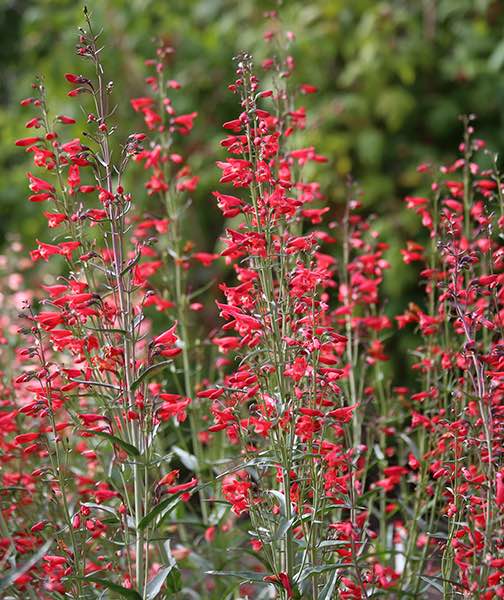

It is even sizeable enough that it can be grown alone in a suitable container. With its upright habit of growth, it is best suited for use as a 'thriller' in the 'spiller-thriller-filler' container combination plant it near the center of the pot, surrounded by smaller plants and those that spill over the edges. Twizzle Scarlet Beard Tongue is a fine choice for the garden, but it is also a good selection for planting in outdoor pots and containers. It can be propagated by division however, as a cultivated variety, be aware that it may be subject to certain restrictions or prohibitions on propagation. This is a selection of a native North American species. It is somewhat tolerant of urban pollution.

Tall stems covered in small scarlet, bell like flowers adding height to borders as they gently sway in the breeze, attracting beneficial insects. It is not particular as to soil type or pH. Bred to be first year flowering, yet still resembling the elegance of the wild penstemon. It is considered to be drought-tolerant, and thus makes an ideal choice for a low-water garden or xeriscape application. It prefers dry to average moisture levels with very well-drained soil, and will often die in standing water.
Penstemon twizzle scarlet full#
This plant does best in full sun to partial shade. Be careful not to disturb the crown in late winter when it may not be readily seen! As an herbaceous perennial, this plant will usually die back to the crown each winter, and will regrow from the base each spring. It grows at a fast rate, and under ideal conditions can be expected to live for approximately 10 years. When grown in masses or used as a bedding plant, individual plants should be spaced approximately 18 inches apart. Twizzle Scarlet Beard Tongue will grow to be about 24 inches tall at maturity, with a spread of 24 inches. Twizzle Scarlet Beard Tongue is recommended for the following landscape applications It has no significant negative characteristics. It is a good choice for attracting bees, butterflies and hummingbirds to your yard. This is a relatively low maintenance plant, and is best cleaned up in early spring before it resumes active growth for the season. Its relatively fine texture sets it apart from other garden plants with less refined foliage. Twizzle Scarlet Beard Tongue is an herbaceous perennial with an upright spreading habit of growth. Its narrow leaves remain green in color throughout the season. Twizzle Scarlet Beard Tongue has masses of beautiful spikes of scarlet tubular flowers with white centers rising above the foliage from early summer to early fall, which are most effective when planted in groupings. Please note, the contents of this blog reflect the views of its author, which are not necessarily those of the RHS.An outstanding, continuous blooming variety with a tall habit stunning, scarlet red flowers rising above green foliage makes an impressive visual impact when massed in the garden, along walkways, or in borders vigorous and low maintenance You can order seed of Penstemon ‘Twizzle Scarlet’ from Plants of Distinction. When I saw it in the summer I admired its prolific flowering, its bright colour and its natural elegance. Happiest in plenty of sun and in well-drained soil, ‘Twizzle Scarlet’ has a relaxed style that ensures it fits well into mixed and perennial borders where it should reach 70-80cm. For that’s its other claim to fame: this colourful perennial flowers well in its first year from a spring sowing. The result is a long season of flower from July to September - from seed sown earlier the same year. Needless to say, this is more than made up for by the tall upright stems along which flowers are crowded in clusters, producing a succession of bloom at each leaf joint. So what’s special about ‘Twizzle Scarlet’? Well, first of all its scarlet, tubular flowers are smaller and more slender than those of the more familiar varieties. And it’s won a Gold Medal from Fleuroselect, the Europe-wide flower seed trialling organisation.
Penstemon twizzle scarlet series#
We tend to think of penstemons as large-flowered and blowsy, but the first of a new series derived from the American native Penstemon barbatus is rather different.


 0 kommentar(er)
0 kommentar(er)
